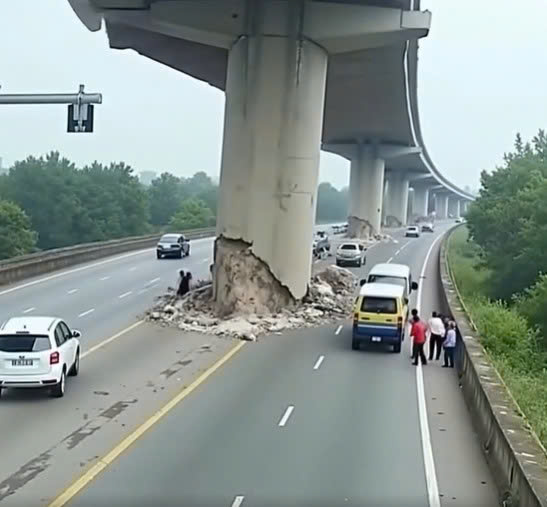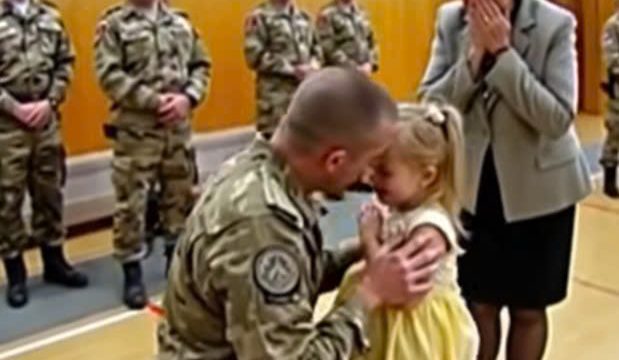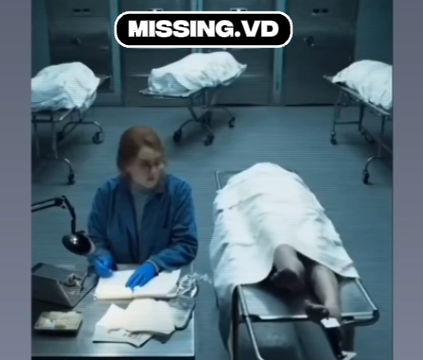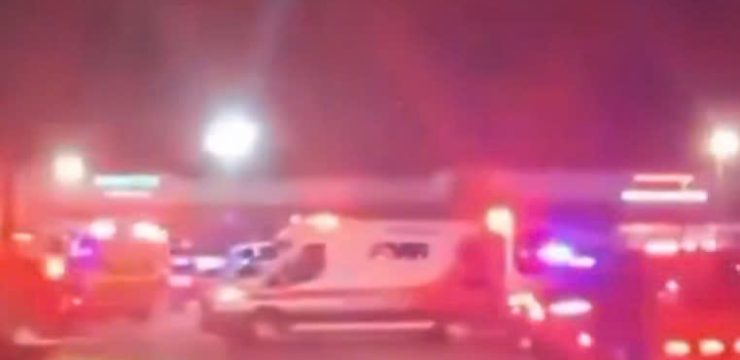When the earthquake struck, the first images that spread across social media showed the frightening sight of a damaged bridge. Chunks of concrete had fallen away from one of its pillars, leaving behind jagged edges and a cloud of dust. At first glance, the scene looked catastrophic, leading many to believe that the entire structure was on the verge of collapse. But as engineers and emergency responders began their assessment, it became clear that the most visible damage was to the outer concrete layer rather than the core of the structure. This discovery meant that while the bridge was badly scarred, its main support systems had not yet failed — a small but significant stroke of fortune that prevented a much larger tragedy.

Emergency crews arrived at the site within minutes of the earthquake subsiding. Their first task was to ensure that no vehicles had been caught beneath the fallen debris. Thankfully, traffic had already been reduced because authorities had issued warnings about possible seismic risks in the area earlier that week. These precautions, though disruptive at the time, may have saved countless lives. By restricting access before disaster struck, officials bought themselves precious time and gave residents a safer chance of avoiding harm.
Still, the damage was serious. The bridge was more than just a physical crossing — it was a lifeline for the community. Stretching over a key route, it connected neighborhoods, facilitated commerce, and allowed families to move freely between work, school, and home. Its sudden closure left drivers searching for long detours and placed strain on alternative routes. As the dust settled, residents understood that while they had been spared the worst, the community was now facing long-term disruptions and the urgent need for repairs.
Engineers wasted no time in examining the structure more closely. What they found deepened concerns. While the first damaged pillar had only lost its outer layer, the next one showed cracks that hinted at more serious vulnerabilities. These fractures, invisible to casual observers, could grow worse with aftershocks or future quakes. The findings served as a wake-up call: even when a structure seems intact, hidden weaknesses can pose significant risks. Engineers emphasized the need for comprehensive inspections of all bridge supports before anyone could safely consider reopening it to the public.
Reconstruction planning began almost immediately. Authorities consulted with seismic safety experts, structural engineers, and government officials to outline the steps necessary to secure the bridge. Reinforcement strategies included adding steel supports, re-pouring concrete with earthquake-resistant mixtures, and installing monitoring systems that could detect stress points before they reached critical failure. This approach was not just about repairing damage but about preparing for the future. With earthquakes an ongoing threat in the region, resilience had to be built into every decision moving forward.
For many residents, the incident sparked important conversations about infrastructure and preparedness. While natural disasters are unpredictable, their impact can often be mitigated by strong building codes, regular maintenance, and community readiness. Some questioned whether the bridge, constructed decades ago, had ever been updated to meet modern seismic standards. Others pointed out that investment in public infrastructure often lags behind political promises, leaving communities vulnerable when disaster inevitably strikes. Local leaders have since pledged to review all critical structures in the area, from schools to hospitals, to ensure they meet higher safety standards.
The broader community response has been a mixture of relief and determination. Relief, because no lives were lost and no serious injuries were reported. Determination, because everyone knows the work is far from finished. Volunteers offered assistance to emergency crews, providing water, meals, and logistical support. Local businesses donated funds to aid reconstruction, while neighborhood associations organized ridesharing networks to help ease transportation challenges caused by the bridge closure. These small acts of solidarity highlighted the resilience of the community and showed that even in times of disruption, people can come together to support one another.
For families who use the bridge daily, the incident has reshaped routines. Parents now wake earlier to get children to school on longer routes. Workers spend extra time in traffic navigating detours. Delivery services have had to adjust schedules, often at higher costs. Yet amid these inconveniences, there is also gratitude. Many acknowledge that the outcome could have been far worse, and that the lessons learned now will hopefully protect the community from future disasters.
Experts also see this as a critical teaching moment. Earthquake-prone regions around the world face similar challenges, and the bridge collapse underscores the need for proactive measures. Structural assessments, retrofitting older buildings, and educating the public about emergency preparedness are all essential steps in reducing risks. While the science of predicting earthquakes remains imperfect, preparation can make the difference between inconvenience and catastrophe.
As reconstruction continues, the damaged bridge stands as both a warning and a symbol. It is a reminder of nature’s power to disrupt human plans in an instant, but also a symbol of human resilience and ingenuity. Engineers are confident that once reinforced, the bridge will not only serve its purpose again but will stand stronger against future quakes. Officials hope that the improvements will also restore public confidence, reassuring residents that safety remains a top priority.
Looking ahead, local leaders stress that this cannot be an isolated effort. Roads, bridges, tunnels, and public buildings all require attention if communities are to remain safe. Funding, political will, and public awareness must converge to ensure that this incident leads to lasting improvements rather than temporary fixes.
In the end, the earthquake revealed more than just cracks in concrete — it revealed cracks in planning, maintenance, and investment. But it also revealed the strength of a community determined to adapt and endure. The damage may have started with one pillar, but the lessons extend far beyond a single bridge. They are lessons about foresight, responsibility, and the collective effort required to face an uncertain future.
As residents adjust to new routines and engineers work tirelessly on repairs, the story of this bridge will live on as both a cautionary tale and a hopeful sign. What began as alarming images of destruction has become a call to action, a chance to build not just stronger infrastructure but also stronger communities. And perhaps that is the lasting legacy of this event — not the fear of what was lost, but the determination to build a safer tomorrow.





